Yes, there are sharks in Jamaica. But, if you are thinking of encountering them, the chances are very slim. The types of sharks found in Jamaican waters vary. However, the most common species include the Caribbean reef shark, sandbar shark, silky shark, nurse shark, and others.
Even some dangerous sharks like tiger, bull and great white sharks are also there in Jamaica. Most sharks prefer to live in deep waters. Therefore, they don’t come too close to beaches or swimming areas around Jamaica’s coastline.
Now in this article, we will explain a bit more about the sharks of Jamaica, their behaviors, and how to stay safe in their presence.
What Sharks Are There in Jamaica?
Let’s know in detail which sharks are there in Jamaica:
Caribbean Reef Sharks
The Caribbean reef shark is found throughout the waters of Jamaica. This species is typically found in shallow waters, near coral reefs and lagoons. They are a common sight along the shoreline of Jamaica, where they often hunt for small fish and other prey items.
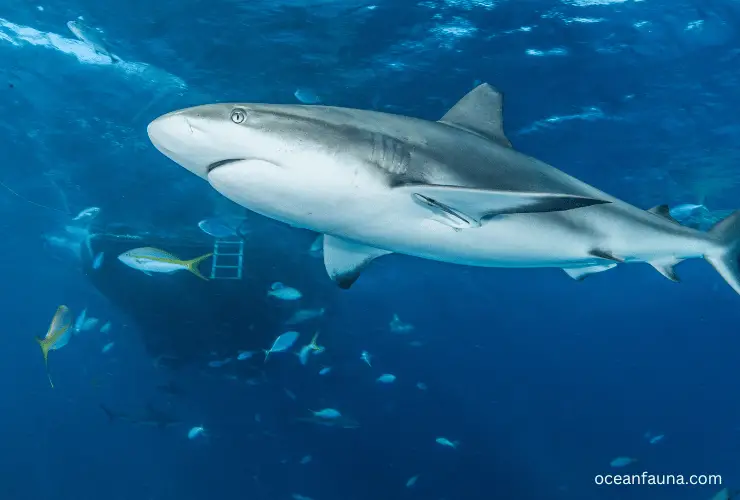
These sharks prefer warm and clear waters, with temperatures ranging from 21 to 27°C (70 to 80°F). The Caribbean reef shark can reach up to 3 meters (10 feet) and is considered one of the most abundant large predators in Jamaica’s coastal ecosystems.
Nurse Sharks
Nurse sharks are an important predator in Jamaican marine ecosystems, as they feed on various types of fish, crustaceans, mollusks, and octopuses. This species is most commonly found close to inshore habitats or shallow coral reefs around Jamaica.
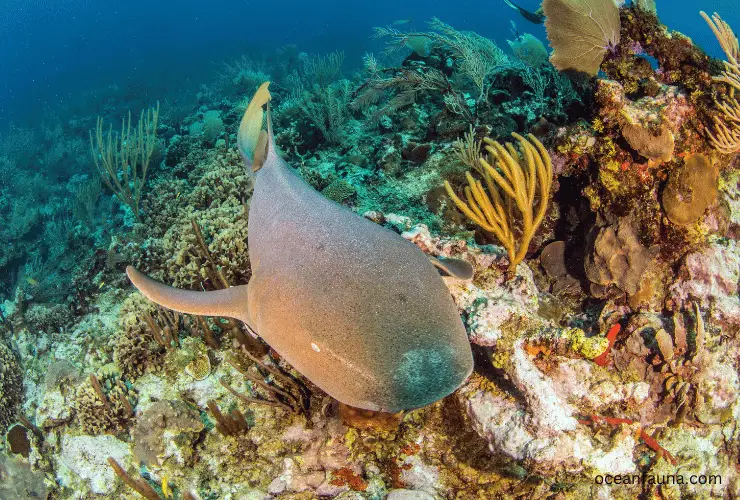
Nurse sharks prefer warm waters with temperatures between 25 and 29°C (77-84°F) and depths typically between 1 meter (3 feet) and 8 meters (26 feet). They can grow up to 4 meters (13 feet) in length, making them one of the largest species of sharks in Jamaica’s waters.
Caribbean Sharpnose Sharks
The Caribbean sharpnose shark is widely distributed in Jamaican coastal areas, from mangrove estuaries to offshore islands. This species prefers warmer water temperatures that range from 22 to 28°C (71-82°F), with depths generally less than 10 meters (33 feet).
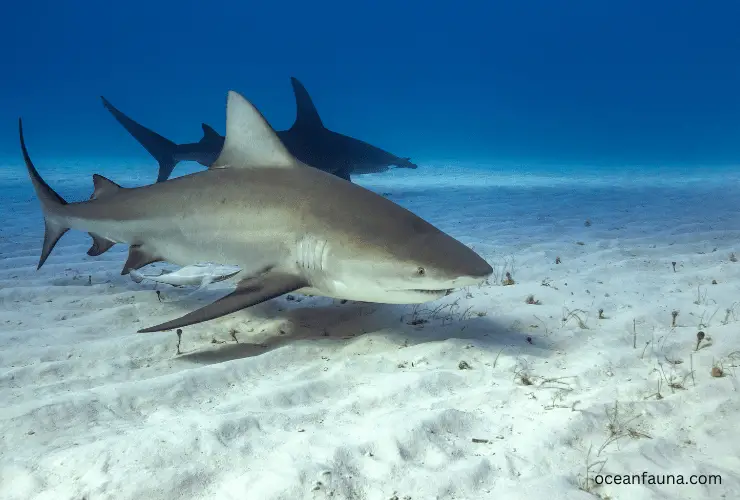
The Caribbean sharpnose can reach a maximum size of around 1 meter (3 feet), although individuals usually measure much smaller than this. These smaller-sized sharks are often seen by divers hunting for small fish in shallow reefs along Jamaica’s coastlines.
Scalloped Hammerhead Sharks
Scalloped hammerhead sharks are well known for their distinctive head shape and wide range of distribution in Jamaican waters. Although they are usually found further offshore than other larger species, such as great white sharks, scalloped hammerheads can occasionally be seen close inshore near coral reefs or rocky outcrops.
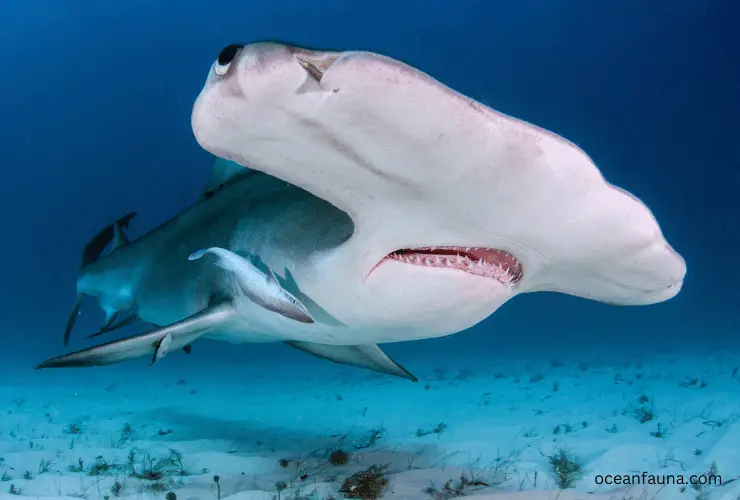
Typically, these sharks inhabit deeper water regions (>30 meters; 98ft) with temperatures between 21-25°C (70-77°F). Scalloped hammerhead sharks have been documented reaching lengths over 5m (~16ft).
Sandbar Sharks
Sandbar sharks are relatively common off the coasts of Jamaica, where they inhabit depths greater than 30m (~98ft). These shy creatures prefer tropical oceanic climates with temperatures between 18-27°C (64-80°F).

Sandbar sharks grow up to 3m (~10ft) in length but usually do not exceed 2m (~6ft) when encountered by divers or fishermen around Jamaica’s shores. Commercial fisheries heavily target these animals due to their large size, high-value fins, and fleshy meat, making them popular worldwide.
Silky Sharks
Silky sharks populate the vast expanses off the coastlines of Jamaica year round but tend to move closer into shallower regions during summer months when the water temperature increases above 24 -25 °C (75 – 77 °F).

Silky sharks prefer deep water habitats with depths greater than 30 m (~98 ft), although males may sometimes enter inshore bays while searching for female partners during mating season. On average silky sharks reach lengths over 3 m(~10 ft ), although some specimens have been measured at over 6 m( ~ 20 ft ) long!
Great Hammerhead Sharks
Great hammerhead shark populations can be found patrolling nearshore regions around Jamaica but generally remain more prevalent further offshore beyond depths greater than 30 m (~98 ft). These majestic predators prefer warm temperature environments ranging from 22 – 28 ° C(71 – 82 ° F ), which may explain why they remain somewhat elusive even within their home ranges off the coastlines of Jamaica.

Great hammerheads can reach an impressive 6 m(~20 ft ) long, making them one of the not largest predatory fishes inhabiting Jamaican seas.
Lemon Sharks
Lemon sharks inhabit virtually all major coastal areas around Jamaica throughout the year, with higher inshore concentrations during summer when warmer temperatures prevail. These elasmobranchs mainly inhabit coastal zones no deeper than 15 m (~49 ft) filled with shallow sandy bottoms.
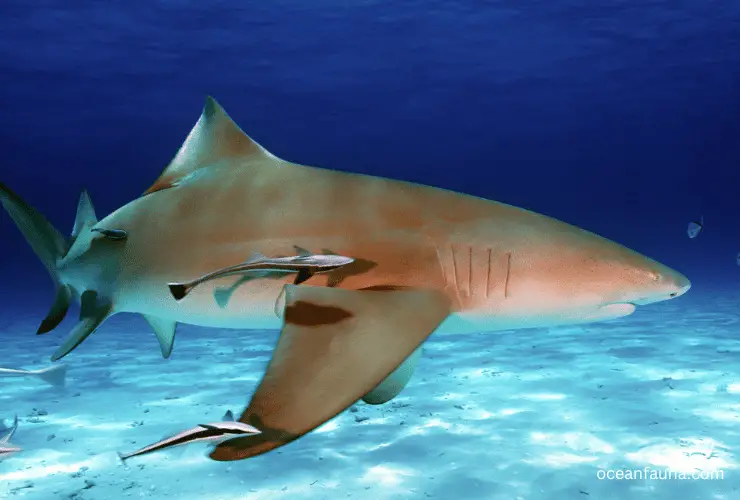
Lemon shark sizes vary greatly depending on age, sex, habitat, etc.; however, maximum lengths have been recorded at nearly 4 m (~ 13 ft).
Blacknose Sharks
Blacknose Shark populations reside mainly inshore near coral reef habitats less than 10 m (~33 ft) deep and filled with nutrient-rich plankton blooms; however, these little predators occasionally venture offshore as well during certain times of the year, significantly when food availability drastically increases within these regions.
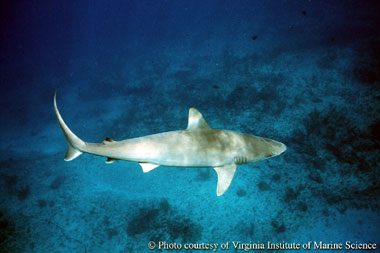
Blacknose Shark sizes typically range between 1 to 1.5 m (~3 – 5 ft), making them one of the smallest species of sharks found in Jamaica’s waters.
Tiger Sharks
Tiger sharks are rarely seen in Jamaica’s waters as they tend to favour distant offshore regions greater than 40 m(~ 131 ft ) deep. These aggressive predators prefer tropical oceanic climates with temperatures between 22-29°C (71-84°F), although they can occasionally be spotted quite close inshore near rocky outcrops or coral reefs.

Tiger sharks are the second largest species of predatory fish in Jamaican seas, reaching maximum lengths over 6m (~20ft).
Bull Sharks
Bull sharks are known to occasionally swim into Jamaican waters, although they generally remain more prevalent in nearby Central American countries such as Costa Rica and Nicaragua. These large predators prefer warm oceanic climates with temperatures between 18-25°C (64-77°F) at depths greater than 15m (~49ft).

Bull sharks grow up to 3m (~10ft) in length relatively quickly, making them formidable predators of any size.
Great White Sharks
Great White Sharks are one of the most feared and respected species in Jamaican waters, although they have only been spotted very rarely due to their preference for colder climates. These apex predators prefer water temperatures between 10-15°C (50-59°F) at depths greater than 30m (~98ft).

Great White Sharks can grow up to 6m (~20ft) in length, making them one of the largest predators known to inhabit Jamaican seas.
How Frequently Can You See a Shark in Jamaica?
Suppose you’re looking to spot some sea dwellers while diving, sailing, or snorkelling in deep Jamaican waters away from the coastlines, your odds of spotting a shark are pretty high. Generally, they’ll be creamy nurse sharks that stay uninterested and placid; however, with luck on your side – it’s not unheard of for reef sharks or Caribbean reef sharks to make an appearance.
Nurse sharks are by far the most prevalent species and are found all along the coastline up to depths of around 150 feet. They tend to be solitary creatures and can often be seen slowly cruising along the sea floor or resting on coral heads or ledges. This species is not considered to be aggressive and will usually flee when approached by humans.
Even if they do become startled, they generally shy away rather than becoming aggressive – though it is still recommended that divers maintain a safe distance from them!
When snorkelling in Jamaica, it’s not always easy to spot a shark due to its camouflage coloration. However, nurse sharks usually stay close to the seafloor, so they can easily blend into their environment and go unnoticed by predators. In addition to this, they have excellent eyesight, so they can detect potential prey nearby even when out of sight!
Although rarer than nurse sharks, reef and Caribbean Reef Sharks can also be found in Jamaican waters until depths up to 260ft – especially around coral reefs or rocky outcrops where food sources like fish and mollusks may congregate. These species typically grow up to 2m (6ft) in length but pose no serious threat unless provoked or surprised.
How Many Shark Attacks Have Been Recorded In Jamaica?
Although fatal shark attacks in Jamaica are incredibly rare, there has been evidence of sharks attacking and injuring humans.
According to records dating back to 1749 by The International Shark Attack File, three unprovoked incidents have occurred over that span in Jamaica – all while spear-fishing activities were taking place in open ocean waters. It’s believed that the fish attracted by underwater noises and smells likely instigated these shark confrontations.
Also, between 2000 and 2020, there have been nine instances of unprovoked shark bites. Caribbean reef sharks were noted to be the primary species involved, although Nurse sharks and Bull sharks are potential threats to beachgoers as well.
In most cases, these attacks have been painful but not fatal and were caused by Caribbean reef sharks or bull sharks. In fact, most cases of shark bites and encounters result in minor injuries to humans or no injuries at all, as sharks will often take only a single bite before releasing a person and swimming away.
Shark attacks remain incredibly unusual, despite the dangers lurking in open ocean waters, even within Jamaica’s coastal regions. Thus, it is imperative to remain aware of potential risks while still enjoying a carefree day by the beach.
At What Season Can Sharks Be Found on The Coast of Jamaica?
Sharks can be found on the coast of Jamaica throughout the year, although they are seen more frequently during certain seasons. During the summer months from May to September, the warm waters around the island create a hospitable environment for various shark species.
Spinner sharks and Caribbean reef sharks are often spotted in shallow waters close to shore during this time, basking in the sun or hunting for their dinner.
During winter months, bigger species like tiger sharks and bull sharks can be found further out to sea as they migrate through Caribbean waters and take advantage of abundant schooling fishes.
Shark encounters are most common around Jamaica’s best dive sites, such as Montego Bay Marine Park, Simon’s Town, Bluefields Bay, and Negril Marine Park. These locations offer some of the best opportunities in Jamaica to view these majestic creatures up close while snorkelling or scuba diving.
How To Stay Safe from Shark Attacks in Jamaica?
Jamaica has breath-taking beaches and awe-inspiring waters but remember that the ocean can be dangerous. As such, anyone who wants to make the most of their visit should take proactive steps for their safety when swimming in shark-infested waters, so they don’t have to worry about a potential attack ruining their trip.
First of all, understand the risk associated with swimming in the ocean of Jamaica. While rare, the highest risk period is between June and November when more people are out swimming and larger numbers of sharks are found closer inshore due to warmer temperatures.
The best way to stay safe from a shark attack is to follow some basic safety tips when entering the water:
- Avoid swimming at dawn or dusk when visibility is low, and sharks are most active.
- Swim with someone else rather than alone – this creates an extra layer of protection against a potential attack and makes help easier to find if needed.
- Don’t wear any jewellery that could attract attention from a curious predator, such as bright colors or shiny pieces.
- If you are diving or snorkelling, stay aware of your surroundings as much as possible – keep yourself near other swimmers or use flotation devices such as buoys or floats that give you something solid to grab onto should you feel threatened by a shark.
- Be aware of warning signs such as large fish moving away from an area quickly or birds circling overhead – both can indicate the presence of a nearby predator.
- Don’t panic if you see a shark – remain calm and get out of the water slowly and carefully while keeping eye contact with the animal until you safely reach the shore.
- Finally, if you spot a large group of sharks in an area, avoid it altogether – even if they don’t pose any immediate threat, they can still cause injuries by bumping into swimmers accidentally.
By following these basic tips and using common sense when entering Jamaican waters, swimmers should be able to enjoy their time without worrying about potential shark attacks during their visit!
Conclusion
Now, it is clear that there are sharks in Jamaica. Although they are not as abundant as in other ocean areas, these apex predators still play an essential role in the local ecology.
So, next time you visit here, take all the precautions before entering the water – avoid swimming alone, stay aware of your surroundings and be prepared to act quickly if a shark is spotted.
